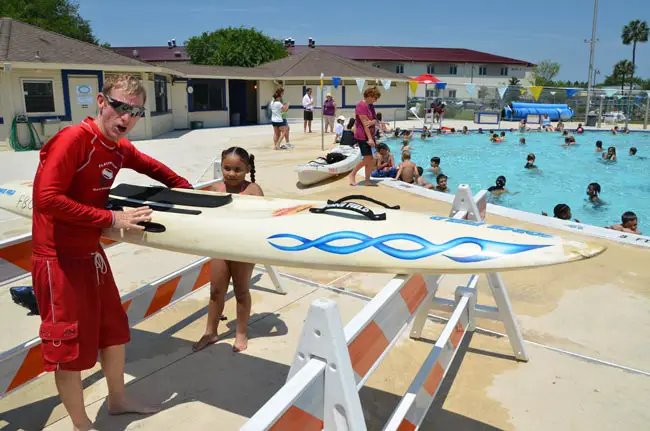
In West Virginia and Kentucky, it’s about track safety: children are taught from the youngest age how to be safe around train tracks, which crisscross coal country like blades of peril. In Florida, it’s about ocean and pool safety: aside from vehicle accidents, drowning is a leading cause of death among children, particularly in Florida, where water–pools, lakes, ponds, rivers, the ocean–is second only to concrete. The state leads the country in the drowning of children under age 5.
In summer, water beckons. Dangers of drowning rise. For the fourth year in a row, Tom Gillin, Flagler Beach’s recreations director and lifeguard-in-chief, has led water-safety clinics for first graders in the weeks immediately preceding summer break. He was at it again Wednesday and today, at the Frieda Zamba pool. Nearby Wadsworth Elementary school–where his wife Nancy, a first-grade teacher, originated the idea–each day sent him three classes of first graders (60 in all) for a two-hour mixture of lessons and pool time. Gillin will soon take his safety class to Old Kings Elementary and Indian Trails Middle School, though without the benefits of a pool there.
“I have all the information that we use in our junior lifeguard programs,” Gillin said. “We’d like to do this in each of the elementary schools, but Wadsworth is really nice because you can actually do it in the pool, and the city of Palm Coast has been great, letting us use the pool for free. So we give a little bit of a safety lecture, teach about rip currents, rescues, how to be safe.”
Gillin explains the physics of rip currents in terms a first grader can understand–let yourself float, don’t panic, go with the flow and know that it stretches about 30 yards or so before it lets up. He warns against swimming anywhere without a lifeguard present, or swimming without a buddy. But pool safety is just as important, if not more so, since most children will end up in the pool at some point this summer. (Five children have drowned so far this year in Volusia County.) Gillin’s advice: never be in a pool without adult supervision–preferably not someone in the pool, but on its rim, for better perspective on all the activity in the pool.
In Florida, it’s just as important for children to know what to do to prevent another child’s drowning, whether in the ocean or in a pool. In that case, Gillin teaches the basics of “reach, throw but never go.” He advises children to extend an object to someone in trouble–a hose, a skimmer pole–or throw something the child can grab onto. Going into the water and up to a person in trouble might lead to a double-drowning as the instinct of those panicking in the water is to grab whatever appears near that. “What you see on TV and what a real drowning victim is are two completely different things,” Gillin says.
That’s their homework assignment–when you go home tonight,” Gillin told his students, “I want you to tell your parents three things that you learned today that you didn’t know before you came here. I’m hoping that they’ll spread the words to their parents and to their friends–just to get the word out on how to be safe.”
It works. Gillin’s presentations to junior lifeguards has parents returning to him to say that their own children are showing them what rip currents look like at the beach. At Frieda Zamba, the 40-minute lecture was payment for what they got afterward: more than an hour in the pool. That worked, too. “They did a great job paying attention,” Gillin said. “I was worried about the attention span of first graders.”





























John Sbordone says
Tom Gillen has been a major asset to this County for many years. Whether at his important job or in one of his many volunteer roles, Tom is always calm, competent and compassionate. We are fortunate to have him in the County. John Sbordone
John Smith says
I wonder how much of the stuff he uses the did city of FB purchased? What do you think there Roger.